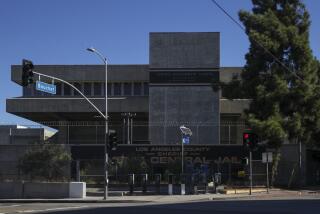No Cuban Holdouts Discovered Hiding in Post-Riot Sweep : FBI Finds Bombs, Thousands of Machetes in Prison
- Share via
ATLANTA — FBI agents Saturday found bottle bombs and thousands of homemade machetes that rebellious Cuban inmates left behind after surrendering the federal penitentiary they ruled for 11 days, authorities said.
But there were no booby traps or holdouts hiding inside the stone prison, said Weldon Kennedy, special agent in charge of the Atlanta FBI office.
Since releasing 89 hostages Friday, 936 inmates have left the prison peacefully and boarded buses bound for 47 other federal prisons across the country, he said. The group included 18 Americans, said Mike Caltabiano, assistant warden at the prison.
The remaining 186 detainees, all Cubans, are housed in Cellblock A and may be kept in Atlanta or moved later.
The machetes were fashioned on prison grinding wheels, Kennedy said.
“They were making them from the very beginning, almost every day,” he said. “There are literally thousands of every description.”
13 Bottle Bombs
One prisoner turned in 13 bottle bombs that had a mixture of naphtha and paint thinner.
The 360 FBI agents, wearing flak jackets and carrying M-16 rifles, began their sweep Saturday in the prison’s tunnel system. No bodies were found, Kennedy said.
Some inmates had claimed that men died in fires set after the prison revolt began Nov. 23, following a U.S.-Cuban agreement that prisoners feared would lead to their return to Cuba.
The agreement also sparked an uprising at a federal detention center in Louisiana, where Cuban inmates surrendered a week ago and released the 26 hostages they had held for eight days.
Each detainee was strip-searched as he left the prison in Atlanta, X-rayed for weapons and handcuffed before boarding a bus to Dobbins Air Force Base, said Justice Department spokesman Patrick Korten. Some prisoners had carried machetes up to four feet long, he said.
Medical Center
One Cuban inmate was transferred to the U.S. Medical Center for Prisoners at Springfield, Mo., Justice Department spokeswoman Evan Gilman said Saturday. She had no details on his condition.
The prison industries building set on fire at the beginning of the takeover was destroyed and will have to be replaced, Kennedy said. Two other buildings that burned, he said, had been scheduled for demolition under a renovation plan.
“This prison will be here for many, many years,” said J. Michael Quinlan, director of the federal Bureau of Prisons. “We are planning to continue renovating the cell houses.”
At the Oakdale, La., federal detention center, Mayor George Mowad said it will cost about $15 million to rebuild the facility, which was largely destroyed in the fires from the rioting.
Contractors have already looked over the center, Mowad said, and he expects the government to begin rebuilding the complex in about 90 days. That job will take about nine months, he said.
In Atlanta, the 85-year-old prison, which once housed gangster Al Capone and was considered one of the toughest in the federal prison system, was undergoing a $63-million renovation when the detainees took it over.
The disturbance began Nov. 23 after Cubans learned that Cuba had agreed to accept the return of 2,500 refugees, mostly criminals or mentally ill, who were among the 125,000 people in the 1980 Mariel boatlift.
Under an agreement between the Cuban detainees in Atlanta and the Justice Department, there will be a moratorium on deportations and all 3,800 Cuban detainees across the nation will have their status determined through an individual administrative review.
Atty. Gen. Edwin Meese III, who toured the penitentiary Friday, declined to say how long the moratorium on deportations would last.
More to Read
Sign up for Essential California
The most important California stories and recommendations in your inbox every morning.
You may occasionally receive promotional content from the Los Angeles Times.










